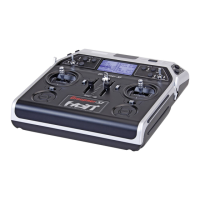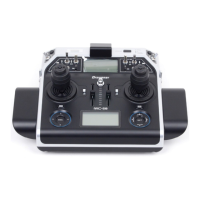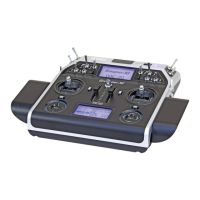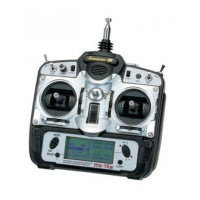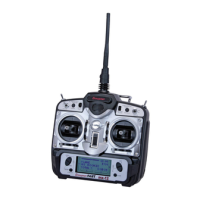131
Program description - Dual Rate / Expo | Helicopter models
Exponential function
If you wish to program the Expo function, use the
button of the left or right-hand four-way button to
move to the right, beyond the Dual Rate value column,
until the word “EXPO” is displayed in the centre of the
screen instead of “DUAL”:
0%
0%
0%
EXPO
–––
–––
–––
SEL
Roll
Nick
Tail
normal
If a switchover between two variants is desired, assign
a switch in the column labelled with the switch
symbol (as described in the section “Physical control,
switch and control switch assignments” on page 60):
0%
100%
100%
Roll
Nick
SR
DUAL
–––
–––
–––
SEL
normal
Move desired switch
to ON position
(ext. switch: SET)
If necessary, this may also be one of the transmitter
control switches C1 … C4 or C1i … C4i or one of the
logical switches L1 … L8 or L1i … L8i from the list of
“expanded switches”.
The switch so assigned appears on the display, to-
gether with a switch icon that indicates the switch’s
switching direction.
In the case of “C” or “L” switches, the stick or another
transmitter control or a certain switching logic can itself
be used as a switch. However, such a control switch
must have been appropriately defined in the »Control
switch« menu, see page 141, and a logical switch
must have been appropriately defined in the »Logi-
cal switch« menu, see page 144 – provided that this
menu point is unlocked (available) on the transmitter
Dual Rate function
If a switchover between two variants is desired, assign
a switch in the column labelled with the
switch
symbol (as described in the section “Physical control,
switch and control switch assignments” on page 60):
100%
100%
100%
Roll
Nick
SR
DUAL
–––
–––
–––
SEL
normal
Move desired switch
to ON position
(ext. switch: SET)
If necessary, this may also be one of the transmitter
control switches C1 … C4 or C1i … C4i or one of the
logical switches L1 … L8 or L1i … L8i from the list of
“expanded switches”.
The switch so assigned appears on the display, to-
gether with a switch icon that indicates the switch’s
switching direction.
In the case of “C” or “L” switches, the stick or another
transmitter control or a certain switching logic can itself
be used as a switch. However, such a control switch
must have been appropriately defined in the »Control
switch« menu, see page 141, and a logical switch
must have been appropriately defined in the »Logi-
cal switch« menu, see page 144 – provided that this
menu point is unlocked (available) on the transmitter
concerned.
Whichever switch has been assigned … the respective
switch will appear in the display together with a switch
symbol indicating the switch’s direction if actuated, e. g.
in the «Normal» flight phase.
100%
100%
100%
Roll
Nick
Tail
DUAL
3
–––
–––
SEL
normal
Once the value field has been activated with a brief
tap on the SET key of the right four-way button, use
the selection keys of the left or right four-way button to
move into the Dual-Rate value column labelled SEL at
the bottom edge of the display in order to separately
change the dual-rate values shown in inverse video for
each of the two switch positions:
100%
100%
DUAL
3
–––
–––
SEL
normal
111%
Roll
Nick
Tail
100%
100%
DUAL
3
–––
–––
SEL
normal
88%
Roll
Nick
Tail
At the same time, the Dual-Rate curve will be present-
ed in the graph.
A simultaneous tap on the or keys of the right
four-way button (CLEAR) will reset a changed entry
field value displayed in inverse video back to “100 %”.
Caution:
For safety reasons, Dual Rate value settings
should not be less than 20 %.
Some examples of Dual Rate values:
Servo travel
Servo travel
Servo travel
Stick deflection
Stick deflection
Stick deflection
Dual Rate = 100%
Dual Rate = 50%
Dual Rate = 20%

